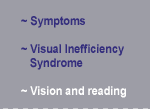


 We use our eyes to read. At a very basic level, the link between vision and reading is self-evident. Most students with Visual Inefficiency Syndrome (VIS) can read -- they just work harder than necessary to do so, and they may therefore avoid reading at all. Basic, beginning-level reading requires good oculomotor control. Students must be able to direct the eyes to the right place on the page, and even to specific letter locations within a word when first learning to read. As novice readers, students' tracking eye movements may not be accurate or smooth; this ability comes with practice. Later, the skills of vergence ("teaming") and accommodation ("focusing") become much more important, as the reader seeks to move beyond just decoding images to the smooth cognitive acquisition of meaning. Moving from a novice reader to an expert reader results in reading fluency, and fluency requires developing one's skills through experience. Most students with VIS fail to notice their inefficiencies simply because they have never experienced anything else. So they never ask for help. Such students are at a clear disadvantage until the VIS block to fluency is removed Reading disability is the most common form of learning disorder.1 Vision problems can be a major contributor to reading disability, and thus can interfere with learning. Dr. Ralph Garzia, an expert in the field of reading and visual dysfunction, has said that, "There can be little question that the initial phases of reading, before phonological encoding, are visual, involving sensory processing ... Visual processes must operate automatically and effortlessly for facile reading."1 1 Mitchell M. Scheiman and Michael W. Rouse, Optometric Management of Learning-Related Vision Problems, Mosby, St. Louis, MO, 1994. |
||||
© 2003 Gemstone Educational Management. All rights reserved.
575 San Pablo Ave., Suite D, Rodeo, CA, USA 94572
Tel.: 510/799-0234 Fax: 510/245-3418